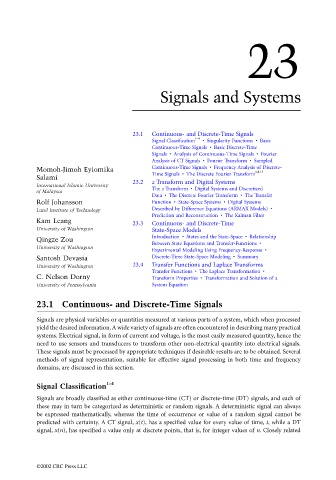Page 693 - The Mechatronics Handbook
P. 693
23
Signals and Systems
23.1 Continuous- and Discrete-Time Signals
1–4
Signal Classification • Singularity Functions • Basic
Continuous-Time Signals • Basic Discrete-Time
Signals • Analysis of Continuous-Time Signals • Fourier
Analysis of CT Signals • Fourier Transform • Sampled
Momoh-Jimoh Eyiomika Continuous-Time Signals • Frequency Analysis of Discrete-
Time Signals • The Discrete Fourier Transform 6,8,13
Salami
23.2 z Transform and Digital Systems
International Islamic University The z Transform • Digital Systems and Discretized
of Malaysia
Data • The Discrete Fourier Transform • The Transfer
Rolf Johansson Function • State-Space Systems • Digital Systems
Lund Institute of Technology Described by Difference Equations (ARMAX Models) •
Prediction and Reconstruction • The Kalman Filter
Kam Leang 23.3 Continuous- and Discrete-Time
University of Washington State-Space Models
Introduction • States and the State-Space • Relationship
Qingze Zou
Between State Equations and Transfer-Functions •
University of Washington
Experimental Modeling Using Frequency-Response •
Santosh Devasia Discrete-Time State-Space Modeling • Summary
University of Washington 23.4 Transfer Functions and Laplace Transforms
Transfer Functions • The Laplace Transformation •
C. Nelson Dorny Transform Properties • Transformation and Solution of a
University of Pennsylvania System Equation
23.1 Continuous- and Discrete-Time Signals
Signals are physical variables or quantities measured at various parts of a system, which when processed
yield the desired information. A wide variety of signals are often encountered in describing many practical
systems. Electrical signal, in form of current and voltage, is the most easily measured quantity, hence the
need to use sensors and transducers to transform other non-electrical quantity into electrical signals.
These signals must be processed by appropriate techniques if desirable results are to be obtained. Several
methods of signal representation, suitable for effective signal processing in both time and frequency
domains, are discussed in this section.
Signal Classification 1–4
Signals are broadly classified as either continuous-time (CT) or discrete-time (DT) signals, and each of
these may in turn be categorized as deterministic or random signals. A deterministic signal can always
be expressed mathematically, whereas the time of occurrence or value of a random signal cannot be
predicted with certainty. A CT signal, x(t), has a specified value for every value of time, t, while a DT
signal, x(n), has specified a value only at discrete points, that is, for integer values of n. Closely related
©2002 CRC Press LLC

